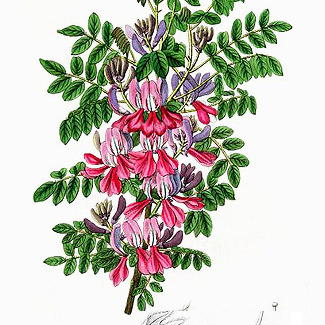Shrubs, 5-20 cm tall. Stems striate, with dense spreading brown 2-branched trichomes with very unequally long arms. Stipules linear, 7-10 mm, abaxially with spreading white or brown trichomes. Leaves 4-10 cm, 13-39-foliolate; petiole absent; rachis with dense spreading brown trichomes; stipels minute or absent; petiolules ca. 1 mm; leaflet blades elliptic to oblong, 7-15 × 4-6 mm, abaxially with dense subbasifixed trichomes, adaxially with slender white appressed medifixed trichomes, secondary veins not visible, base cuneate to rounded, apex obtuse to rounded and mucronate. Racemes 5-15 cm; peduncle and rachis with dense spreading long white trichomes; peduncle 4-7 mm; bracts linear to narrowly triangular, 8-10 mm, abaxially with long spreading white trichomes. Pedicel ca. 3 mm, with long spreading trichomes. Calyx ca. 3 mm, outside with long spreading white trichomes; tube ca. 2 mm; teeth triangular, ca. 1 mm. Corolla pink; standard elliptic to oblong, 8-10 × ca. 4.5 mm, outside with dense spreading brown or white long trichomes, apex mucronate; wings oblong, 8-9 mm, glabrous, margin ciliate; keel 8-9 mm, outside apically with spreading white trichomes, margin ciliate, apex acute. Stamens 7.5-9 mm; anthers hairy at base. Ovary with dense appressed white trichomes. Legume linear, cylindric, deflexed to spreading, 3-4 cm × 3-4 mm, with white appressed 2-branched trichomes; endocarp not blotched. Seeds 6-10 per legume, dark brown, cubic, 1.5-2 × 1.5-2 mm. Fl. Apr-Jun, fr. Jun-Aug.
More
A shrub. It grows to 2 m high. The leaves have an odd number of leaflets arranged along the stalk. There are 15-23 leaflets. They are narrow and oblong. They are covered with fine hairs. The flowers are pink. They occur along a stalk in the axils of leaves. The pod is like a cylinder and covered with short hairs.
It is a subtropical plant. In Nepal is grows between 1000-3000 m altitude. It grows in hedges and along tracks. In southern China it grows on valley slopes between 1,800-2,500 m above sea level.
More
Valley slopes; at elevations from 1,800-2,500 metres. Evergreen forest, open pine forest, secondary vegetation and grassland; at elevations from 800-2,400 metres.

